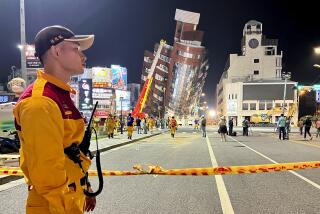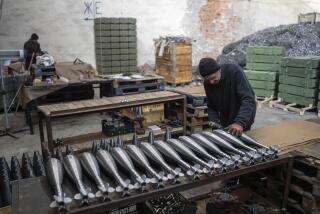PACIFIC REPORT : Of Arms and the Japanese : Defense: The Pentagon is using more of its ally’s commercially developed technology in weapons. That makes many Japanese providers uneasy.
- Share via
TOKYO — As allied jets scream across Iraqi skies and their tanks gather near the Kuwaiti border, conspicuously absent from the scene is equipment from Japan, the world’s second-largest economic power.
Hobbled by strict rules against weapons exports and chased into hiding by Japan’s pacifist public, the weapons industry has remained small and well-camouflaged.
Yet, Japan’s emerging technological leadership, its strong desire for an independent defense system and the Pentagon’s shrinking budget are drawing Japanese industry inextricably into the business of war.
In the search for ways to cut costs and boost quality, American weapons manufacturers have increasingly chosen to use Japanese electronics components, ranging from communications-related semiconductors to optical devices from video cameras.
And a steady stream of Pentagon officials is making its way to Japan, where industry has demonstrated its ability to tap civilian technology to build sophisticated weapons systems--including state-of-the-art tanks and missiles--on shoestring budgets.
“Japan has one of the strongest technology-based economies in the world,” says a Department of Defense official who deals with the relationship. “We want to tap that.”
The military relationship between the two allies promises to be a minefield, however. Japanese companies, with the exception of a few large defense contractors, fear being tainted by association with the weapons business and see little benefit from offering their technology to U.S. defense contractors. American companies, in turn, don’t want to be bound by Japanese laws that could restrict use of weapons containing Japanese technology.
Japan’s defense effort is Lilliputian compared to that of the United States. The Japan Defense Agency had a budget slightly more than $30 billion in 1989, one tenth that of the Pentagon. And Japan’s $650-million budget for defense research and development was roughly one-sixtieth of the United States’.
Like America, Japan’s defense establishment is facing tighter budgets. Defense spending in Japan’s five-year plan beginning this year will grow just 3% a year, compared to 5% in the last plan. In three years, when a bulge in aircraft orders is filled, military aircraft production will plunge 25%.
Japan is better able to handle the slowdown. For one, the military’s job is strictly defined: the protection of the Japanese archipelago and its immediate surrounding sea. For the job, Japan maintains a Self-Defense Force which has at its core 150,000 soldiers, 53 destroyers and 300 fighter planes. By relying on the U.S. nuclear umbrella, Japan avoids heavy spending on costly strategic weapons.
Japan’s defense production is also spread across a large number of diversified companies, so defense cutbacks won’t mean layoffs and bankruptcies, as it could in America. Only a handful of Japanese firms depend on defense business for more than 10% of sales.
The nation has also learned to do with less. Japan has kept its defense budget low by drawing heavily on foreign military technology and domestic technology developed for commercial use.
Where Japan doesn’t have the capability to develop weapons on its own, such as the Patriot missile and the F-15 fighter, it manufactures the products under license. By adding commercial testing and maintenance systems to the products, Pentagon officials admit, Japan has often boosted the quality and cut the down time of U.S.-developed systems.
At the same time, Japan has gradually built up an advanced arsenal of weaponry developed to match local conditions. By minimizing bureaucratic red tape and leaving the bulk of weapons development up to largely civilian companies that design weapons with production costs in mind, the defense establishment has kept costs low and avoided the giant cost overruns common in American companies that specialize primarily in defense.
Last year, Mitsubishi Heavy Industries completed the Type 90 tank, based on--but more advanced than--the quick-moving German Leopold and American M-1 tanks. Despite cost overruns, the tank cost $230 million to develop, compared to the $1-billion-plus price tag on the M-1.
“If you are not first to develop something, you know what path to take and you can take a safer, cheaper way with fewer mistakes,” says Tsukasa Nishida, a retired major general from the Self-Defense Force.
Japan added some important innovations of its own. The Type 90 has automatic loading devices so it can be operated by a crew of three, instead of the four required for the M-1. It can quickly engulf itself in a cloud of smoke to deflect lasers used by enemy planes to pick out their targets. The tanks are also smaller so they can pass through narrow Japanese roads.
Japan has also cut development costs by focusing its research on areas like missiles, where its civilian technology gives it an advantage. “Missiles require a lot of electronics so they take advantage of our strength, and they are good for use on air, land and sea,” says Toshitsugu Tanaka, director of the plans division at the Defense Agency’s Technical Research and Development Institute.
When Toshiba developed its portable surface-to-air missile system, it looked closely at General Dynamics’ Stinger, which can shoot down aircraft by following the heat emitted from the back of fighter planes. But Toshiba drew from its semiconductor and consumer research to add an imaging device that enables the missile to target a plane from head-on while avoiding being sidetracked by decoys. The missile uses a charged coupled device, an image-sensing component found in every video camera, to keep a close eye on its target.
Toshiba’s product was among the first Japanese achievements to catch the attention of the U.S. defense establishment. The Pentagon initially expressed interest in the technology but changed its mind in 1987, after a Toshiba subsidiary was caught selling to the Soviet Union sophisticated machine tools that could be used to manufacture quieter submarines.
Japan also cut missile development costs by basing most systems on the same core technology, much as auto companies build many models using the same engine and parts. The SSM-I, Japan’s surface-to-surface missile, which reportedly impressed Pentagon officials during tests in California a few years back, cost only $150 million to develop because it was based on a previously developed air-to-sea missile.
Some critics say Japan could save even more by purchasing its weapons systems from America. Because so few of any given weapons are built, per-piece costs are high. The Type 90 tanks, for example, cost $10 million each.
Japanese defense officials, however, say they don’t want to be overly dependent on America. “The basics of defense is you have to be able to make the products yourself, even if you are surrounded, like Iraq,” says Michio Sasaki, secretary general of the defense production committee at Keidanren, the nation’s big business association.
And, like the United States, Japan sees the defense sector as an arena for testing frontier technologies. “New materials are costly when they are first developed; you can’t immediately use them in tennis rackets,” says an official of Japan’s Ministry of International Trade and Industry. “The defense business provides a market for new technologies.”
It was a desire to generate its own aerospace technology that persuaded Japan to pursue a costly effort to develop its own fighter, the FSX. Under American pressure, the project has become a joint development effort based on the F-16.
Ironically, what started as an indigenous project has become a conduit for the first significant flow of technology from Japan to America. The wings, for example, will be made by Mitsubishi Heavy Industries using a special process for curing composite materials that, if successful, will make them lighter, stronger and cheaper to manufacture. Mitsubishi Heavy, Japan’s largest defense contractor, agreed to offer the technology to General Dynamics only under pressure from the Japan Defense Agency.
The Pentagon will also get the technology for a sophisticated radar system currently the size of a truck that Mitsubishi Electric has shrunk into a space small enough to be put on board the fighter.
Squabbles in the initial contract and mutual recriminations over delays and cost overruns have created mistrust between the two sides. However, says one U.S. defense official, “now there is an understanding that technical interdependence has to be managed.”
Japanese and U.S. defense officials are negotiating joint development in five areas, including more efficient rocket engines, missile guidance systems that use miniaturization to combine infrared and radar capabilities to find a target, and ceramic materials for use in propulsion systems.
“We have far more defense technology (than the Japanese); we want to use that to leverage (their) commercial technology,” a Pentagon official says.
He said the United States wants the Japan Defense Agency to take U.S. defense technology and see how Japan can apply nondefense technology to improve it or reduce development costs. Ideally, the official said, the Pentagon would then like to see the relevant technology licensed to a U.S. manufacturer or manufactured in America by the subsidiary of a Japanese company.
Japanese electronics companies, which generally get less than 4% of sales from the defense sector, say they don’t want to let go of their strategic technologies and have little use for the narrow technologies that U.S. defense firms want to offer in return. Rules governing export of dual technology for defense use are vague, and most companies say they would just as soon avoid the trouble.
That could change if exporting weapons were legalized, but that seems unlikely soon. “We will never allow weapons exports,” says Tsuyoshi Nakai, director of international trade policy planning at MITI. “That is how the situation in Iraq came about.”
In the meantime, Japanese commodity components are becoming an increasingly important part of American defense systems. Special Japanese-made chips used in home satellite systems, for example, are also the cheapest and best quality for use in military communications.
Some are critical of the trend. “You can’t be a military superpower if you are chained to a 6,000-mile supply line to Japan,” says John Stern, head of the American Electronics Assn.’s Tokyo office.
But defense officials say most of those parts can be stockpiled, avoiding concern over dependence on Japanese. “We just go to the bins and pull out whatever we need,” said an executive at a major U.S. defense contractor.
JAPAN’S LAGGING DEFENSE SPENDING
Military expenditures, 1989
Expenditures In billions As % Country of dollars* of GNP United States 289.1 6.1 United Kingdom 34.5 4.3 France 36.4 3.8 W. Germany 35.0 2.9 Italy 20.8 2.5 Japan 29.4 1.0
*in constant 1988 dollars and exchange rates
Source: Stockholm International Peace Research Institute
JAPAN’S TOP CONTRACTORS
Defense contracts, fiscal 1989
Contracts Company (in millions$) Mitsubishi Heavy Industries Ltd. $2,180 Kawasaki Heavy Industries Ltd. 1,300 Mitsubishi Electric 859 NEC Corp. 546 Toshiba Corp. 523 Ishikawajima-Harima Heavy Industries 484 Japan Steel Works 238 Hitachi Zosen Corp. 200 Komatsu Ltd. 181 Fuji Heavy Industries 166
Sources: Japan Defense Agency, Japan Company’s Handbook
More to Read
Sign up for Essential California
The most important California stories and recommendations in your inbox every morning.
You may occasionally receive promotional content from the Los Angeles Times.










